Issue:September 2021
SPECIAL FEATURE - Injection Devices: Designing Simplicity, Safety & Adherence Into One Delivery System
The global injectable drug delivery devices market is expected to show significant growth in the coming years as manufacturers introduce technological advancements and product innovation meant to improve convenience, compliance, and ease of administration of parenterals. Additionally, the increasing preference for at-home self-injection is driving the market as patients prefer to continue to avoid healthcare settings post-COVID. With all of this taken into account, one market study predicts the global market to reach almost $26 billion by 2025, up from $15 billion in 2020.1 However, another report values the global market at $42.76 billion in 2021 and expects it to reach $50.9 billion in 2025.2
How the numbers will play out is yet to be determined, but the studies do highlight the focus on single-use and reusable systems. Disposable-use prefilled syringes (PFS) are increasingly used due to the prevalence of chronic diseases and the growing number of biologics best delivered by syringes. Single-use autoinjectors are also poised to experience increased demand, particularly with the growing pervasiveness of anaphylaxis disorders. Autoinjectors also provide a convenient alternative to manual syringe injections for subcutaneous administration.
But their reusable brethren, such as pen injectors with prefilled cartridge, are also proving viable syringe alternatives. These injectors can perform hundreds of injections, with patients controlling the speed of delivery to minimize pain or discomfort during use.
“Making injection devices partially reusable is a cost-saving strategy,” says William Fortina, Business Development Director, Duoject Medical Systems. “Ideally, the device’s mechanism and/or electronics are the reusable parts of the system – as these are often the costliest – and the drug containers and needle are one-time use.”
Another cost-saving strategy that several large pharmaceutical companies are deploying is to develop a device platform for multiple drug products in their portfolio, says Mr. Fortina. “This allows them to spend resources on a single significant development program, for one optimal injection device, which then requires minimal customization for each subsequent product line.”
Despite efforts to make better, safer, simpler injection devices, patient adherence is still a challenge associated with self-administration. This has resulted in the emergence of smart devices, such as wearable injectors, which share patient data with healthcare providers to ensure compliance. And while it is expected this sector will continue to grow, some industry insiders warn against making these devices too intrusive.
“Smart devices, interconnectivity, and related technology provide real-time data to healthcare providers for analysis, but these device additions should not increase risks, including patient understanding of treatment delivery, or jeopardize compliance,” says Michael Denzer, Vice President of Technical Solutions at Kymanox. “Data collection needs to be “passive” to the patient. In other words, invisible to the patient’s use of the device so that the collected data provides a true benefit to the end user. If these design considerations can be implemented without impacting the patient or how they administer and receive treatment, then smart devices can provide advantages to the patient and the industry.”
This annual Drug Development & Delivery report takes a deep dive into the myriad injectables that are either currently in development or recently introduced to the market.
Aptar Pharma: RFID-Enabled Rigid Needle Shields for Unit Serialization & Track and Trace
Today, traceability of parenteral drug products is performed at the batch level. Health and regulatory authorities are currently looking into implementing unit serialization (Policy paper on traceability of medical products, WHO, 2021) to improve traceability from production through to patients. “Individual container traceability could dramatically improve patient safety, preventing potential mix-ups, clarifying accountability, and simplifying investigations in case of deviation during fill-finish operations,” says Audrey Chardonnet, Business Director, Aptar Pharma. “Current strategies are reaching their technical limitations and new approaches must be considered to address future requirements.”
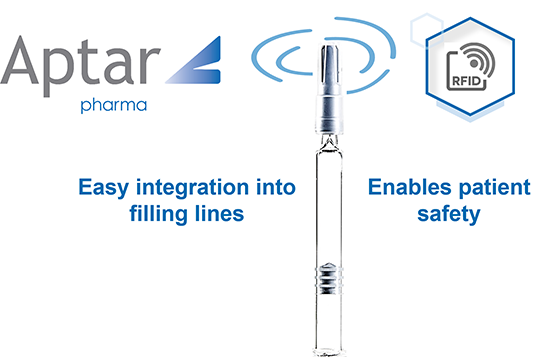
Most identification strategies for injectable drugs rely on physical stickers applied onto the drug container during filling, a method that Ms. Chardonnet says is hardly applicable to unit serialization. Different technologies were considered and eventually narrowed down to two options: the engraving of a 2D-matrix on the glass container or digital chips. 2D-matrices are relatively easy to engrave on the glass, but require the installation of engraving equipment – either on the filling or glass manufacturing lines – and advanced camera systems for reading the matrix. Because it is physically engraved on the glass, the matrix cannot be read through secondary packaging and requires the container to be oriented on the filling line to allow reading. Adding a digital chip to the packaging allows individual serialization and brings further benefits. Industrial implementation requires the addition of a contactless reader to identify the dose at any point during the process – even through a secondary packaging – and the tag can be edited to attach more information on-the-go.
“The idea of unit serialization is often associated with prefilled syringes (PFS),” she says. “In addition to well-documented advantages over multi-dose or single-dose vials, including ease-of-use, safety, and reduced drug wastage, unit serialization eliminates the need for a distinct injection device, thus ensuring the patient receives the dose directly from the device that carries the tag, reducing risk of mix-ups before the injection.”
Aptar Pharma’s RFID RNS is a digitally-enabled RNS that leverages RFID technology, miniaturizing and embedding it in the RNS plastic shell. This chip acts as a tag that can be read and edited at any time from the filling process to the time of injection. “The RFID RNS enables easy implementation of unit-dose “track and trace” processes on the filing lines thanks to contactless reading/editing of the RFID chip,” Ms. Chardonnet explains. The RFID RNS allows high-throughput unit identification without impacting the filling lines beyond the addition of a reader.
BD Medical Pharmaceutical Systems: Usability is Built Into All Devices
At BD, the “smartification” of delivery devices is guided by a user-centric approach. Extensive human factors studies help to ensure that added functionalities serve to enhance, not detract, from usability. In fact, BD has conducted more than 80 human factors studies on its portfolio of products since 2010. Network security and environmental sustainability (potential pollution from electronic waste) are also critical issues every smart solution must address, says Beth DiLauri-McBride, Chronic Portfolio Marketing Director, BD Medical-Pharmaceutical Systems.
Beyond usability, new functionalities such as the ability to verify a drug’s authenticity, can be achieved through smart traceability solutions. “BD is developing a traceability solution that aims to reduce manufacturing mix-ups and help to provide manufacturing to point-of-care traceability in the long term,” says Marie-Liesse Le Corfec, Head of Portfolio Marketing for BD Medical-Pharmaceutical Systems. “This BD whole-system approach is based on simple, robust, and market-proven technologies and encompasses tagged and nested prefilled syringes, readers, and software as part of a fully tested and ready-to-use system.”
BD also is focused on developing robust PFS solutions for the delivery of sensitive biologics while ensuring that each solution has supply availability to meet customers’ demands. To achieve this, BD has developed an array of solutions for the testing and delivery of drugs or vaccines. “Most recently, we expanded our service capabilities and acquired ZebraSci,” says Ms. Le Corfec. “Also, our PFS portfolio includes both coated and uncoated stoppers and bare or siliconized barrels, using, for example, baked or cross-linked silicone.”
An example of BD cross-linked silicone technology is the BD NeopakTM XSiTM Glass Prefillable Syringe that helps protect against lubricant-drug interaction, while supporting the full gliding performance essential to innovative drug formulations aiming to increase payload.
BD SCFTM PremiumCoat® Plunger Stoppers for chronic drug delivery applications help protect drugs from component interaction, while aiming to improve delivery system performance.
Bespak by Recipharm: Developing Connectivity Across a Range of Autoinjectors
Digital health provides many benefits when transitioning treatments into the hands of patients. When the physical interactions between doctors and patients are reduced, smart, digitally connected devices can improve patient engagement, record compliance, and monitor clinical effectiveness. “Adding digital features to autoinjectors without adding any additional user steps is key to the adoption of such new technology,” says Hans Jensen, Global Business Development Director of Bespak by Recipharm.
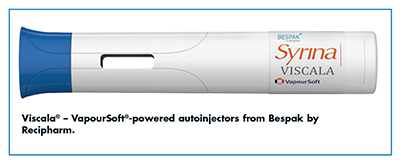
He says factors to consider include:
- Minimal impact on device design – ensures the device is unchanged in terms of size, shape, and how it is operated, so patients don’t have to re-learn how to administer their medicine.
- Flexible interface architecture – enables integration into a connectivity suite that both patients and HCPs can use, and can be tailored to the usability needs of the target patients.
- Bluetooth® connectivity – harness wireless communication technology, so that patients can simply connect their device to their smartphones without having to spend time setting up new and unfamiliar technology.
Bespak by Recipharm is developing connectivity features that can be used across its range of autoinjectors. Its VapourSoft® autoinjector platform, including Viscala®, was designed particularly for biologics and long-acting formulations. “Viscala delivers formulations with very high viscosities – something traditional spring-powered devices are struggling to achieve,” he says.
Viscala® uses the proprietary VapourSoft technology, which uses liquefied gas as the power source, rather than a traditional spring. Mr. Jensen says the benefits of VapourSoft include the ability to generate high forces within the device without damaging the syringe, delivery through patient-friendly fine needles, constant force profile throughout the delivery phase, and easy adjustment of forces by selection of gas from range of available gasses.
Catalent Biologics: Helping Pharma Partners Post-COVID
Now that COVID-19 vaccines are in production and available, Catalent has seen some of its partners shift their focus back towards non-COVID related treatments, and this includes the growing interest in “off-the-shelf” (OTS) style autoinjectors. “Historically, route of administration decisions have been made later in development, with many innovators opting for providing drugs in vials in order to reduce drug/device development complexity,” says Brian Galliher, Principal Process Engineer, Catalent Biologics. “What is more apparent now is that pharma companies are working to address key end-user questions earlier, to enable a more patient-friendly experience as soon as commercial approval is achieved. This renewed focus on non-COVID indications earlier in development may lead to more self-injection options, such as OTS autoinjectors.”
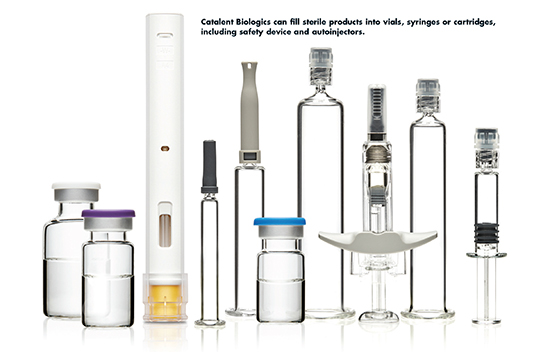
Over the past year, devices assembled at Catalent for customers have included anti-needlestick devices and autoinjectors for biologics used to treat autoimmune disorders.
Credence MedSystems, Inc.: Enhancing & Facilitating Intravitreal Drug Delivery
While Credence MedSystems is scaling its Companion and Dual Chamber Reconstitution Syringe Systems to meet demand from pharma customers, the company has also advanced development of its ophthalmology and gene therapy solutions. These therapeutic areas share some common requirements for drug delivery, including the requirement to deliver extremely low injection volumes with precise accuracy, the need for user-friendly solutions that do not encumber the procedure, and the need to maintain lower injection forces despite the possibility for high viscosity injectables.
Credence is developing the Micro-DoseTM Syringe System, designed to deliver a nominal dose ranging from 50μL down to below 20μL, with high accuracy. With Micro-Dose, the clinician simply presses on the plunger rod until it stops moving, explains John A. Merhige, Chief Commercial Officer, Credence MedSystems, Inc. The allowable travel length of the plunger rod determines the removing a source of user error. The device allows the user to control removal of the air bubble by turning the safety cover. “This helps prevent valuable drug from being wasted during conventional air bubble purging, and can allow reduction of overfill requirements, leading to economic benefits,” he says.
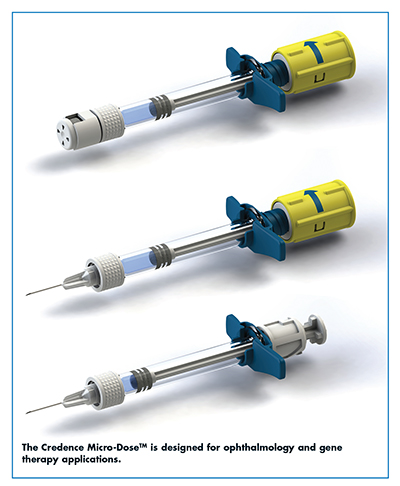
A sister product to Micro-Dose is Multi-Site™, which allows similar precision but repeated administration of multiple doses from the same syringe in the same procedure. This product has application in certain ophthalmology applications, cosmetic applications, and dental applications.
Additionally, as pharma manufacturers develop biologics that require more viscous formulations, the ability to maintain lower injection forces becomes critical, especially with intravitreal injections. Credence is developing an adjunct technology that can be used with its Micro-Dose and Multi-Site technologies called Force-AssistTM, which uses a levered advantage to reduce the force required to inject by roughly one-third of that which would be required in a traditional delivery system. Mr. Merhige says: “With the delivery of viscous fluids through very narrow/high gauge needles, this technology can enable caregivers to maintain control of the injection and avoid discomfort to the patient, while still achieving precise low-dose accuracy.”
SHL Medical: Modular Platform Technology Addresses Today’s Self-Injection Trends
Subcutaneous self-injections are evolving as a preferred choice owing to the advances in biologic formulations. “As self-injection technology matures, there is a compelling need for a flexible device platform that can be leveraged across a number of therapies without compromising injection experience or patient acceptance,” says Magnus Fastmarken, Director of Marketing at SHL Medical.
The evolution of SHL’s Molly® device technology corresponds to the growth of the autoinjector market. Introduced in 2010 as a preconfigured solution, Molly has been applied in treatments for diseases such as Rheumatoid Arthritis, migraine, osteoporosis, and atopic dermatitis, among others. Following the development of pharmacologic therapies targeting weight loss, Molly now also supports treatment for obesity.
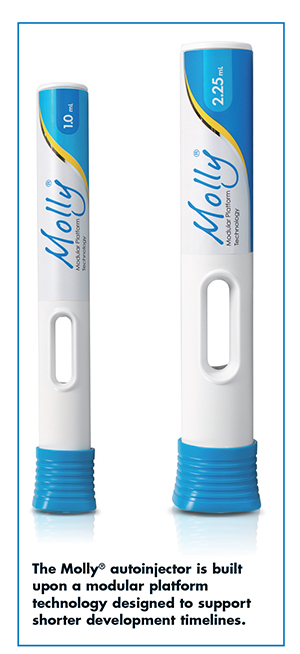
“Molly’s modularization offers cost effectiveness in device manufacturing and provides flexibility in the device designs and fill volumes, allowing for design modification according to specific combination product project needs,” says Mr. Fastmarken. He adds that the modular technology in both the 1.0mL and 2.25mL standard versions of Molly autoinjectors enables design customizations in the front and rear sub-assemblies of specific device projects while keeping the core components intact.
In response to the need to introduce different dosing volumes for different target markets, SHL helped a pharma company lifecycle an existing product into the Molly and Molly 2.25 devices for hypercholesterolemia. “This not only demonstrates how Molly can support pharma companies in meeting their branding requirements, but also in accommodating patient-centric device designs to support pharma’s commercial strategies,” Mr. Fastmarken says. “With Molly, SHL seeks to reduce the development time and resources while ensuring compatibility between a drug product and the device. By sharing commonality of a modular platform, SHL is also able to share manufacturing assets across multiple Molly device projects, contributing to the optimization of costs, development timelines, as well as the overall environmental impact from producing and operating individual machinery.”
SHL has been working with Molly’s platform technology to develop digital initiatives supporting connected therapeutics to address the shift from administering injections in clinical settings to homecare settings. Mr. Fastmarken says digital interventions in self-injection devices need to provide flexible and sustainable offerings to facilitate different patient behaviors and treatments. “We are in the development phase of solutions that can achieve the functionality and usability of a traditional autoinjector with additional features that allow for connected health capabilities, while mitigating the environmental impacts.”
Mitsubishi Gas Chemical Co., Inc.: Staked-Needle Syringe Targeted to Biologics
Mitsubishi Gas Chemical Co., Inc. has been focusing on developing staked-needle syringes and plans to start providing samples in 2022. The targeted therapeutic is biologics and the targeted users are biopharma and conventional drug companies.
The staked needle syringe can decrease the possibilities of needle-stick injury and eliminate the loss of time to attach a needle to syringe, according to Tomohiro Suzuki, Associate General Manager, New Business Development, Mitsubishi Gas Chemical Co., Inc. “Many customers have asked for staked needles, and we can change the needle length and gage based on requests and demands, so the syringes will handle every viscosity.”
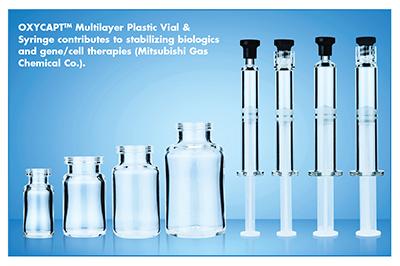
The new syringes are made of a multilayer plastic with a high oxygen and UV barrier. He says: “As there is an issue of breakage with glass containers, and COP monolayer syringes don’t have sufficient oxygen or UV barrier protection, the new staked needle product avoids the risk of breakage and offers stability to oxygen- and UV-sensitive drugs.”
He adds that the multilayer plastic vial and syringe, OXYCAPTTM, will contribute to stabilizing every kind of drug.
Nemera: Finding a Balance Between Safety & Simplicity
For Nemera, the ultimate goal is to find this right balance between simplicity and robustness of drug delivery devices. Safety and ease-of-use are two of the crucial characteristics in advanced parenteral devices. To that end, Nemera has been focusing on developing and manufacturing safe injection devices that foster patient adherence and improve the self-administration experience as well as ease-of-use.
“Patients with chronic conditions who require lifelong medication need enhanced comfort to manage their treatment, particularly when self-administering complex, large-volume, high-value biologic drugs, such as monoclonal antibodies,” says Severine Duband, Category Director, Devices, Nemera. “They need a robust, advanced drug delivery device that also offers simplicity and ease-of-use. On the other hand, patients who have specific and complex conditions – such as oncology, neurology, hematology – also need safe devices to inject their complex drugs and to avoid hospital/healthcare professional intervention. This need is increasing with the trend of switching from intravenous to subcutaneous delivery.”

To address the increased trend toward self-administration of large-volume biologics, Nemera’s key focus this year has been on the development of an on-body injector platform for complex, large-volume drugs (20mL) delivery, such as monoclonal antibodies with an adjustable flow rate to fit both patients’ and drugs’ administration profiles. And, it is sustainable thanks to its reusable electronic part and drug-containing disposable element.
As an example, the PENDURA AD is a platform dedicated to manufacturing a reusable pen injector that integrates an automatic, spring-driven feature coupled with a side activation button. Its technological solution allows the ergonomic location of the dose-release button on the side of the pen, ensuring stabilizing the hand holding the pen by resting it against the body during dosing, says Audrey Chandra, Category Project Manager, Nemera.
Owen Mumford Pharmaceutical Services: Expanding Platform to Address High-Volume Biologics
Owen Mumford Pharmaceutical Services has been focusing on its passive safety syringes this past year. These are typically used for subcutaneous administration of therapies for a variety of treatments, such as multiple sclerosis, Rheumatoid Arthritis, and Crohn’s disease. The addition of a needle protection safety feature ensures patient safety and compliance with needlestick prevention regulations.
“We have expanded our UniSafe® platform with the addition of a 2.25mL device,” says Michael Earl, Director of Owen Mumford Pharmaceutical Services. “Like the existing UniSafe 1mL, the product features a spring-free design that prevents pre-activation during transit and provides a simple final assembly,” he explains. “From a patient perspective, the absence of a spring helps with drug visualization and checking in the syringe barrel before and during administration, and also provides the same simple administration technique as a prefilled syringe. Additionally, the absence of a spring as well as preventing pre-activation in transit also helps with drug inspection prior to patient administration in addition to providing a longer shelf life of 3 years.”

He adds that the increasing number of higher volume (>1mL) biologics coming to market has resulted in the growth of 2.25mL prefilled syringes and the need for associated safety devices. “The launch of UniSafe 2.25 makes it particularly suitable for delivery of these types of formulations.”
Stevanato Group: Platform Designed for Compliance & Speed to Market
During the past year, Stevanato Group has focused on pen injectors and emergency autoinjectors. The SG Alina® is a customizable pen injector designed to target diabetes, focusing on insulin and GLP-1 therapies.
“SG Alina promotes better compliance and more effective treatment, aiding efforts to reduce costs and improve quality of care,” says Adam Stops, PhD, Product Management Drug Delivery Systems, Stevanato Group.
Other advantages include: delivery forces that suit all demographics; ergonomic design of the dose dialing; labeling space for enhanced readability; cap designed for ease of use and durability; and optimized dose numbering.
The pen injector also has been designed as a platform to speed time to market for pharmaceutical companies, while also bringing the benefits of Stevanato’s end-to-end solutions, such as glass products, automated assembly, and visual inspection equipment, as well as analytical services, says Dr. Stops.
Vetter: Leveraging Devices for a Range of Therapies
Vetter specializes in filling, assembling, and packaging of injection systems, and is keeping a close eye on several areas where the injectable product landscape is evolving rapidly. The company has already pursued several projects to evaluate a range of different pens, autoinjectors, and wearable systems.

“We’re particularly interested in how we can leverage these devices for therapeutic areas such as autoimmune diseases, growth disorders, migraine, oncology, and Type 2 diabetes,” says Markus Hoerburger, Product & Service Manager at Vetter. “Patients with these conditions may derive particularly valuable benefits from treatments that are easier to self-administer at home.”
This, he says, is particularly true as a result of the pandemic. “Self-injection products will play an increasingly valuable role in driving compliance, protecting high-risk patients, and reducing the need for clinic-based treatment.”
ApiJect: Responding to Demand for Equity & Supply Chain Shortages
Global demand is rising for equitable access to medicine, including injectables. Self-injection is already standard for insulin, many migraine drugs, and biologics. ApiJect is developing products responsive to this demand, such as a scalable, low-cost, simple-to-use injection system that can potentially enable many patients to self-inject prescription medicines with minimal training, explains Dawn Carlson, Senior Director of Program Management at ApiJect.
“ApiJect’s focus includes developing a new generation of simple, easily manufactured, prefilled syringes,” says Marc Koska, ApiJect’s Founder and Head of R&D. “We’re seeking both to enable high-speed, high-volume drug or vaccine delivery in the urgency of the pandemic, and to help solve the problem of how to inject populations in low- and middle-income countries.”
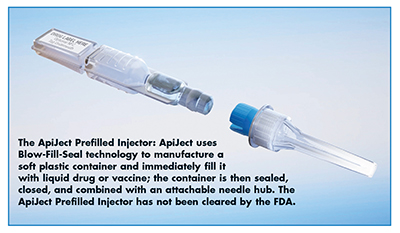
The ApiJect Prefilled Injector, which, as this article went to press, has not been approved by the FDA, is a single-unit dose, soft plastic device. It is pressure-activated rather than incorporating traditional barrel-and-plunger features. “We’re developing a broad platform enabling rapid scale-up for many types of injectable applications,” says Ms. Carlson. “Our targeted user naturally depends on the specific drug that is packaged in the device.”
By designing a prefilled syringe that employs Blow-Fill-Seal (BFS) technology, Mr. Koska says ApiJect expects to offer advantages of safety, speed, and reliable aseptic filling at prices that are highly economical and competitive with disposable syringes and multi-dose glass vials.
“BFS frees drug packaging from dependency on the supply chain used for glass vials, rubber stoppers, metal crimps, and other traditional syringe and vial components,” says Ms. Carlson. “Our injector only requires plastic resin and an intramuscular needle. We plan to be our own needle supplier. BFS is well-established technology, widely recognized as inherently safe and effective.”
“Ever since the COVID-19 crisis began, pharmaceutical companies have been struggling with global “just-in-time” supply chains for glass vials and syringes,” explains Mr. Koska. “These supply chains are highly vulnerable to disruptions that range from raw materials shortages to fill-finish capacity limits and even government export bans.”
Ms. Carlson adds: “The ApiJect platform uses BFS to offer pharmaceutical companies an alternative to traditional supply chains. Our platform enables massive production scale-up on short notice; reliable aseptic filling; and much-reduced raw materials requirements. In addition, ApiJect Prefilled Injectors combine the advantages of prefilled formats with the economy of multi-dose vials and disposable syringes.”
DALI Medical Devices: Self- Injection Features in One Device
One of the most important takeaways from the COVID-19 pandemic has been the search for ways to reduce the burden and pressure on hospitals. To make this happen, self-injection treatments should be available for the home environment, says Ziv Cahani, Vice President Business Development and Marketing for DALI Medical Devices.
He says demand for DALI’s SAN® product family of self-injection devices was booming this past year. The SANs offer features that directly address the patients’ needs:
- Automatic needle insertion to the correct depth (SC/IM), so the patient doesn’t need to worry if the needle wasn’t inserted into the right depth or require assistance from a nurse or other health care professional.
- Automatic passive needle sharps protection against needlestick injuries.
- Hidden needle before and after injection for patients who suffer from needle phobia.
- Manual control of injection speed to help the patient control the pain level.

“With this one-of-a-kind combination of features, SAN-L not only meets the needs of a range of patient needs, but guarantees that the entire injection treatment is more comfortable and that the medications are delivered safely and securely,” he says.
Mr. Cahani adds that more drugs (mainly biologics and biosimilars) are being developed for subcutaneous injection. Many of these have different physical and chemical parameters (e.g., viscosity), so there is a need to customize the SAN product design accordingly (e.g., adapt to different-sized needles). The SAN self-injection device’s needles range is between 18 and 29 gauge.
As an example of how SAN can be adopted and adapted, one pharma company’s commercial team sought a unique device to include one of its drug’s self-injection kit. The drug was in a prefilled syringe. “The team approached DALI because it was looking for a highly differentiated product, one that required special features to meet the specific design and injection requirements of the needle,” says Mr. Cahani. “And, of course, too, they wanted to offer a solution that patients would like.”
He adds that SAN-L is the culmination of all necessary self-injection features in one product design.
Datwyler: Cartridge Plungers Feature Rubber Coatings for Improved Drug Compatibility
The development of an injectable drug-device combination is a complex process that requires substantial investment of resources and money to achieve desired and successful outcomes. A variety of self-injection device platforms are available that offer benefits like shorter time-to-clinic, lower up-front investments, and lower project risks.
For example, on-body injector devices, also known as large-volume injectors or wearable devices, are on the rise. These devices can be a good choice for the delivery of larger volumes of highly viscous biological drugs given the even and controlled pressure profile they can offer, explains Carina van Eester, Global Product Leader, Prefilled Syringes and Cartridges at Datwyler. Various device companies develop platform devices that can handle volumes up to 20mL, most of which make use of prefilled cartridges. Cartridges utilize established materials, components, and filling processes. Datwyler’s portfolio includes larger-sized plungers for cartridge barrels up to an internal diameter of 23.85mm.
In many cases, the drugs that go into these self-injection devices are biological drugs that require a coated rubber closure. Datwyler offers OmniFlexTM coated serum stoppers and NeoFlexTM plungers that have the same composition and are made out of the FM457 compound with a fluoropolymer coating on top. The components are fully coated so the drug runs no risk of touching uncoated rubber, says Ms. Eester. “The benefit of using the same rubber formulation and coating at both ends of the drug product is reduced complexity during extractable and leachable studies,” she says. “Datwyler’s coated solutions provide drug compatibility, functionality, and machineability. The fluoropolymer spray coating provides a barrier to extractables and leachables while ensuring smooth delivery in the field.”
The NeoFlex plungers and OmniFlex stoppers are 100-percent camera inspected and meet demand for quality and performance for highly sensitive, large-molecule drugs. To complete the closure, Datwyler offers a range of aluminum seals that are produced, controlled, and tested under stringent conditions.
Duoject Medical Systems: Responding to Changing Healthcare Needs
In recent months, Duoject Medical Systems has been working on self-contained injection devices – devices that don’t require additional packaging. The Maverick emergency auto- injector is a good example of this. It does not require any additional protective casing to contain the device as the patient carries it on them constantly, explains William Fortina, Business Development Director, Duoject Medical Systems.
“This is a crucial advantage for someone facing a life-threating event such as an anaphylactic shock; it allows for completing the injection faster.” He adds that developing devices without extra packaging or casing can also be an eco-friendly argument.
Duoject has also focused efforts on user-step reduction, which in the context of self-administration and at-home care, makes the device more patient friendly. “This in turn increases the likelihood of patient adherence and reduces chances of user errors,” says Mr. Fortina.
Some of Duoject’s pharma clients are increasingly interested in platform devices that allow pharmaceutical labs to reuse a device platform for multiple applications with minimal customization required. “If a novel technology is necessary, Duoject applies its robust design process,” he continues. “When designing new drug reconstitution and injection devices, we put an emphasis on early iterative prototyping and human factors testing to find out friction points and flaws early on, and eliminate them from the design before moving on to the actual device development phase.”
Finally, Duoject continues developing reconstitution systems for lyophilized drugs. He says that different systems allow clients to combine different primary containers: vial-to-vial reconstitution (Helium device), syringe-to-vial (Xenon and EZ-Link adaptors), and vial-to-cartridge (PenPrep EVO). These reconstitution systems are helpful as pharma companies develop more complex molecules and biologics, which are sometimes only stable in lyo form.
Enable Injections: Flexible & Convenient Care
The healthcare system, post-COVID, will demand flexible drug delivery options. Enable Injections has spent time with key opinion leaders to better understand the shifting patient and provider needs throughout the COVID-19 pandemic. The need to reduce patient exposure to viruses and free up healthcare resources has driven unprecedented innovation in drug delivery. As a result, patients, providers, and healthcare systems are embracing more flexible care.
The enFuse® is suited for flexible care, says Matt Huddleston, Chief Technology Officer and Executive Vice President of Business Development at Enable. “And our flexible delivery model, EnywhereCareTM with enFuse, allows a range of delivery options for patients and providers, from in-clinic to at-home self-administration of therapeutics.”
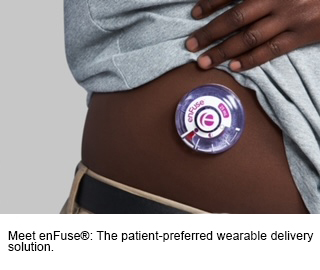
As patients transition to the home in a flexible care model, maintaining the same quality of care will require delivery technology to provide solutions to connect with their physicians, other patients, training, reminders, and confirmation of delivery success. One of the many ways in which Enable is working to maintain this quality of care is through the development of the Smart enFuse, which supports next-generation patient/healthcare provider connections and enables flexibility in the site of care, explains Jennifer Estep, Senior Director, Marketing & Strategy at Enable.
In the past year, Enable has focused on the validation and clinical success of the enFuse delivery solution. Two clinical trials were recently completed, and another trial is in progress. “These clinical trials demonstrate our ability to subcutaneously (SC) deliver large volumes – 25mL and more – without the use of chemical additives or enhancers,” says Mr. Huddleston. “For patients currently receiving care with a large-volume subcutaneous delivery device at home on their own, 100% of these patients reported they prefer the enFuse over the current alternative SC method of delivery. Our goal is to enable convenience for the patient, with the goal of making a positive difference in patient compliance.”
Flex: Human Factors Engineering Simplifies the Complex
In this highly competitive industry, the most successful companies have established rapid product development cycles that incorporate robust usability studies. By putting people at the center of medical device design strategy, human factors engineering (HFE) can drive products that simplify the user experience.
“With a deep understanding of user needs and expectations, HFE experts can be involved at each step of the development process, from early user needs definition through summative usability validation, to ensure that the disparate needs of distinct user groups are met,” says Jennifer Samproni, Chief Technology Officer of Health Solutions at Flex. “The resulting product may be more complex while advantageously being perceived as more user-friendly.”
At Flex, human factors and engineering teams have integrated multiple sensors into novel autoinjectors that are specifically designed to administer biologics, she explains. “This technology can vastly improve user compliance by simplifying the number of factors the user must track.”
Accurate temperature sensing is also of utmost importance because many biologics require cold chain storage. The automated injector can verify the temperature of the drug and either prevent the injection from starting, warm up the drug via active heating or adjust the injection force. Rotary encoder and force sensors can be used together to arm the motor driving unit with more accurate data to support different injection profiles and deliver a consistent patient experience. “In each of these examples, smarter, more complex systems actually simplify the workflow and user experience,” she says.
Haselmeier GmbH: Smart Drug Delivery in Clinical Trials
Big tech is delivering leading technologies supporting the paradigm shift in healthcare, not only with the collection of patients’ data but also how they make use of that data. As a result, wearables and connected devices are increasingly finding their way into clinical trials. For example, Johnson & Johnson’s Heartline study is using data from the Apple Watch to support earlier detection of arterial fibrillation in patients (www.heartline.com). This study, initiated in 2020, seeks to enroll 150,000 patients.
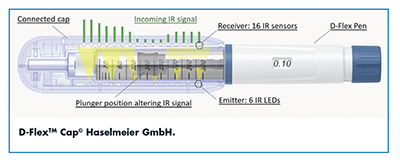
The future of clinical trials is becoming more reliant on connected medical devices: Collecting data at the point of care, reducing the need for costly patient visits and cumbersome manual data acquisition.
Therefore, Haselmeier developed the D-FlexTM Ecosystem, a connected drug delivery solution that can be integrated into mobile solutions, collecting injection data at the point of care. The system is based on a proven technology, which was successfully used in a clinical trial with 75 patients completed in July 2018, says Frank Leipold, Business Development Digital Solutions, Haselmeier. The learnings from that trial translated into the new D-Flex Ecosystem (https://doi.org/ 10.2337/dc18-1631).
The D-Flex Ecosystem consists of the disposable D-FlexTM injection pen and the connected cap, which replaces the standard cap of the pen. The connected cap tracks injection dose, temperature, and time up to 1,000 injection events. It securely transfers data in real-time to the Haselmeier patient app and cloud or any other pre-existing data management system via Bluetooth Low Energy. As an option, customers can choose to have the data stored and forwarded to the data management system at a later date. This eliminates the need for a patient mobile phone.
The D-Flex injection pen is at the heart of this connected solution, says Terry O’Hagan, Managing Director, Haselmeier Inc. “D-Flex is a complete platform allowing for simplified adaption of specific injection dose volumes by changing only one component. This saves time and cost during clinical testing, especially with dose ranging studies, because it allows using the same pen for all clinical testing and product launch, eliminating the need for additional equivalence/user studies.”
The connected cap identifies the actual dose delivered by the pen by comparing the position of the plunger before and after each injection. Six LEDs emit an infrared (IR) signal that is altered by the plunger position. Sixteen IR sensors then detect the incoming signal. The delta between the two states identifies the relative movement of the plunger, delivering the actual expelled dose during an injection. This way, the cap calculates and displays the remaining volume in the cartridge.
Kahle Automation: Custom Equipment for Various Injection Devices
According to Julie Logothetis, President of Kahle Automation, regardless of design and safety advances, the needle and syringe play an integral role in drug delivery from low dead space designs that maximize the dosing of the COVID-19 vaccine to auto-retractable syringes and unique new injection device designs that provide for economic self-contained devices that allow vaccine injections that can be easily distributed worldwide and meet single-use injection requirements.
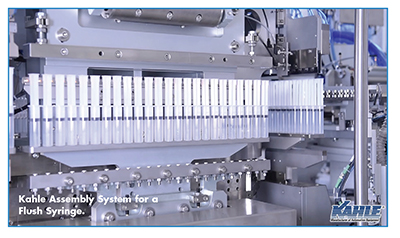
Kahle Automation has been designing and building custom high-speed automation equipment for multiple injection device projects, providing solutions that assemble devices from 10ppm to 700ppm with completely validated manufacturing and packaging systems to meet the demands of the industry. Current projects include micro-injection devices for ocular injections, low-dead-space safety needles and syringes, auto-retractable syringes that self-destruct once the injection is delivered, and glass syringes that allow for the drug and the delivery system to be combined into one device.
Kymanox: Accelerating Device Development & Delivery
While Kymanox is not a device manufacturer, the company provides drug and device manufacturers with end-to-end solutions to accelerate device development and delivery. “Right First Time” is how Kymanox approaches product and process development and engineering, says Michael Denzer, Vice President of Technical Solutions, Kymanox. “Our integrated solutions, which include project management, quality assurance, regulatory affairs, clinical and medical affairs, and digital transformation, support and drive our clients’ device development projects to deliver products to patients with optimized safety, quality, efficacy, and accessibility.”
Kymanox has worked on a variety of handheld and wearable injection devices including single-use and multi-use cartridge-based devices. The therapeutic applications include critical care and emergency use as well as chronic disease management. The targeted users range from adolescents to seniors and include patients who have to prepare the treatment themselves.
“For sensitive biologics, patients must reconstitute the drug and, at times, adjust the injectable volume for their body weight,” says Mr. Denzer. “These activities add confusion and anxiety to the patient. At Kymanox, we strive to simplify this process as much as possible.”
SCHOTT: Syringes Aimed at Improved Compliance
Patient compliance relies on quick, pain-free injection experiences. Optimized for integration with autoinjectors, SCHOTT’s syriQ® BioPure prefilled glass syringe underpins the self-injection experience through its influence on injection force and duration. With dimensional tolerances that go beyond ISO specifications, syriQ BioPure supports consistent injection times of less than 10 seconds. “Designed for sensitive biologics, with ultra-low tungsten residual levels, low particulate, and low homogeneous silicone levels, syriQ BioPure PFS supports the ideal patient experience,” says Michelle Deutsch, Senior Global Product Manager, Glass Syringes, SCHOTT.
SCHOTT’s primary packaging works with various industry device solutions, such as the family of YpsoMate® 1mL and 2.25mL autoinjectors from Ypsomed. The YpsoMate autoinjector is an automated disposable injection device for 1mL-long prefilled syringes. The device is triggered by push-on-skin activation. Ypsomed responds to the challenge of adherence and therapy management by providing the SmartPilotTM for YpsoMate, a reusable add-on that transforms YpsoMate into a fully connected smart product system.
In addition to syriQ BioPure glass PFS, SCHOTT TOPPAC® syringes are suitable containers to be used inside injection devices. SCHOTT TOPPAC offers customers the possibility to individualize Cyclic Olefin Copolymer (COC) containers for self-injection delivery to match their specific needs. “The flexibility and precision of injection molding the COC material with their low particulate, as well as the low silicone levels, provide an especially promising containment option in the biologics space,” says Tom van Ginneken, Senior Global Product Manager Polymer Solutions at SCHOTT.
Sonceboz: Ease of Use & Implementation Are Critical
Sonceboz is focused on devices that provide a balance between ease of use and ease of implementation. “While the first is a requirement by regulatory bodies, the latter should not be put out of focus,” says Thomas Mayer, Business Unit Manager, Sonceboz. “A number of device programs fail because they are too complex to integrate into existing and proven pharma processes.”
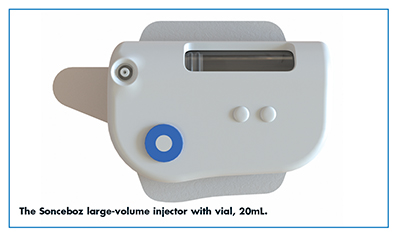
As an example, he points to primary drug containers. “Primary packaging is key in protecting the integrity and safety of a drug product and barriers for change are high. For this reason, we focus on compatibility with standard vials in our lead device, the LVI-P20.” While the lead device is built for compatibility with any vial container, a later lifecycle management device, such as the LVI-P20, is focused on maximum ease of use with reduced use-steps.
Mayer explains that the Sonceboz devices deliver large volumes, up to 20mL and more, in a compact package and are flexible as well. “We work with existing and proven containers, we cater to complex use cases involving multiple containers, and offer an innovative business model that allows our partners to innovate based on our core architecture composed of the GentleTouchTM fluid path and pump, as well as WhisperDrive brushless motors.”
West Pharmaceutical Services, Inc.: Digitally Enabled Product Strategy
“West believes the solution lies in simplifying the journey for the patient, physician, and pharmaceutical company,” says Lawton E. Laurence, Senior Director, Applied Research & Technology for West.
To that end, the SmartDose® 10 Injector has seen increasing customer demand driven by its ease of use, flexible performance, and the company’s experience with commercializing wearable injectors, he continues. “In comparison to burdening oncology clinics with developing bespoke programs to safely administer drug therapies at home, a drug approved for use with our SmartDose 10 injector means those requirements are addressed through the system’s patientcentric design and validated through rigorous human factors studies.”
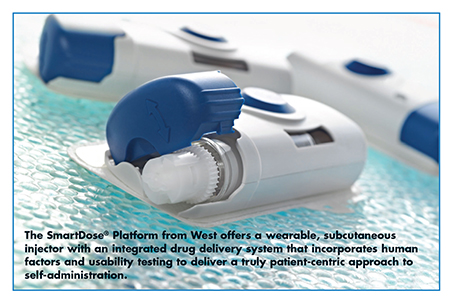
Mr. Laurence says one concern West has heard from oncologists is around patient adherence. “For cancer patients, a missed or delayed dose can have life-changing ramifications that don’t necessarily exist with other diseases. Based on this therapeutic specific insight, we are developing a solution that would add remote dose capture and an injection metric data stream without sacrificing the user experience that has been so well received. The result is our concept development effort for the connected SmartDose 10 injector, which will leverage our IoT technology platform and the West digital ecosystem.“
With the advent of this system, the patient care team will receive critical information regarding the patient’s adherence and experience. When the injection is successful, confirmation will be registered in real time along with any qualitative experiential data the patient records in an automated post-injection report. In the event a dose is overdue, an escalating series of interventions will be triggered. Starting with a text message reminder and potentially progressing up to a home visit, the intervention protocol will be customized based on the therapy’s risk profile. “We believe a digitally enabled combination product strategy produces the best possible experience for patients, helps accelerate therapy availability where it’s needed, and lowers the overall cost to the healthcare system,” he says.
Ypsomed: Smart, Reusable Prefilled Pens
Smarter injection devices are part of the current innovation life cycle and will be an integral part of digital therapy management ecosystems. The complexity of the smart componentry depends on the type of therapy. For example, Ypsomed sees demand for smart, reusable, prefilled pens for short-acting insulin to treating Type 1 diabetes in combination with continuous glucose monitoring and dedicated apps. This provides patients with a real-time bolus calculator and HCPs with an overview of blood-sugar levels over time, explains Ian Thompson, Vice President Business Development, Ypsomed Delivery Systems.
“For prefilled autoinjectors, there is always the question of what level of smartness works best for a particular therapy,” says Mr. Thompson. “A connected, reusable add-on provides advanced patient guidance and detailed injection logging, but adds user steps, which may be best suited to certain therapies where patient behavior is critical and closely monitored. As many patients receive support from therapy apps for their conditions, we also see a demand for prefilled devices with built-in electronics that will provide basic device guidance and injection logging.”

YpsoDose is a cartridge-based patch injector that is prefilled, preassembled, and electromechanical in this device category. For infrequent large injections of antibody therapies currently administered intravenously, Mr. Thompson expects YpsoDose to provide a safe and easy-to-use format for the hospital/clinical environment and for specialist therapies in the home setting. “In the hospital setting, YpsoDose will free up valuable infusion infrastructure, reduce the risk of dosing errors, and save time for healthcare professionals treating patients with life-saving oncology drugs,” he says. YpsoDose is currently being industrialized for use in clinical trials.
“Patient compliance is improved by simplifying the user handling steps to “patch and inject,” and providing audible and visual feedback, which has been confirmed in comparative human factors testing,” says Mr. Thompson.
Congruence Medical Solutions: Pioneering Flexible Dosing Solutions
Congruence Medical Solutions is developing a number of drug delivery device platforms aimed at applications involving microliter dosing, maximizing injection flexibility, and minimizing drug waste. Emerging needs of injectable drugs currently in development require more flexibility than most injection device platforms can currently provide, explains Phil Green, PhD, Head of Commercial and Business Development at Congruence. Several variables inform development and selection of a device platforms, including injection volume, formulation viscosity, regulatory compliance, needle safety, cost, human factors, and more.
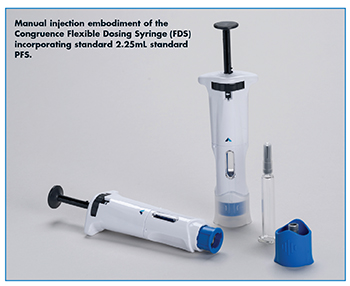
“These afford flexibility for a pharmaceutical partner across the entire portfolio of drugs irrespective of stage of clinical development,” says Dr. Green. “Development of the Congruence Flexible Dosing Syringe (FDS) platform aims to provide this flexibility to pharmaceutical companies.”
Some potent immunotherapeutic agents in oncology require a range of dose volumes based on patient weight or other factors. Also, drugs with pediatric indications may require significantly different dose volume than for adults. The maximum dose for most pen injectors, which allows variable dosing, is 1mL or less. The FDS has been developed to accommodate a wide range or injection volumes (50 microliters through 2.25mL). “Flexibility in injection volume also may be an important capability for dose ranging studies during clinical trials; minimizing re-formulation costs for a clinical stage drug,” Dr. Green says.
While water-like viscosity is preferable from an injection system standpoint, increasingly formulations are getting more viscous. The FDS platform accommodates increasing viscous formulations, and has demonstrated ability to inject formulations as high as 1500cP with standard prefilled syringes.
“It is beneficial for a device platform to afford greater flexibility necessary during clinical drug development, but also bridge to a commercial embodiment with minor modifications. The flexibility afforded by the Congruence FDS can help bridge the clinical embodiment of the injection device with corresponding commercial embodiment. For example, a manual FDS injection device could be used in clinical trials, but an FDS autoinjector could be the commercial embodiment,” he says. The Congruence FDS can be made available in both a manual injection and an autoinjector format.
References
- Injectable Drug Delivery Devices Global Market Report 2021: COVID-19 Growth and Change to 2030, ResearchandMarkets.com, March 21, 2021, https://www.businesswire.com/news/home/20210521005182/en/Global-Injectable-Drug-Delivery-Devices-Market-Report-2021-Market-is-Expected-to-Reach-25.79-Billion-in-2025—COVID-19-Impacts-Growth-and-Changes-to-2030—ResearchAndMarkets.com.
- Drug Delivery Devices Global Market Report 2021: COVID-19 Implications and Growth to 2030, ResearchAndMarkets, Aug. 6, 2021,https://www.businesswire.com/news/home/20210806005310/en/Drug-Delivery-Devices-Global-Markets-Report-2021-Oral-Injectable-Topical-Ocular-Pulmonary-Nasal-Transmusocal-Implantables—ResearchAndMarkets.com.
Total Page Views: 24498









